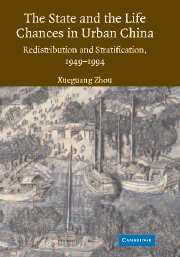Book contents
- Frontmatter
- Contents
- List of Figures
- List of Tables
- Preface
- Credit Line
- 1 Redistribution and Stratification Dynamics Under State Socialism
- 2 Overview: Historical Context and Research Design
- PART ONE REDISTRIBUTION AND STRATIFICATION DYNAMICS: EMPIRICAL EVIDENCE
- PART TWO ASSESSING INSTITUTIONAL CHANGES IN THE POST-MAO ERA
- PART THREE SUMMARY AND CONCLUSION
- References
- Index
2 - Overview: Historical Context and Research Design
Published online by Cambridge University Press: 28 October 2009
- Frontmatter
- Contents
- List of Figures
- List of Tables
- Preface
- Credit Line
- 1 Redistribution and Stratification Dynamics Under State Socialism
- 2 Overview: Historical Context and Research Design
- PART ONE REDISTRIBUTION AND STRATIFICATION DYNAMICS: EMPIRICAL EVIDENCE
- PART TWO ASSESSING INSTITUTIONAL CHANGES IN THE POST-MAO ERA
- PART THREE SUMMARY AND CONCLUSION
- References
- Index
Summary
This chapter provides an overview of the evolution of the state socialist redistributive institutions in the People's Republic of China, from 1949 to the 1990s. We accomplish this goal in two ways: First, we use official statistics and documentary evidence to introduce the historical context in which our study is situated and to familiarize the reader with major historical events and episodes in China. Second, we use more detailed life history information of a national sample of urban residents – the main data for the studies reported in this book – to describe historical changes in individual life chances in such areas as educational attainment, labor force composition in types of organizations and occupations, as well as across economic sectors.
For anyone familiar with the Chinese context, it would be difficult to discuss the People's Republic of China without paying attention to, and indeed giving prominence to, the distinctive, evolving historical contexts in its brief but turbulent history. Therefore, we begin with a discussion of the historical context by first describing – and emphasizing – the distinctive historical periods of the People's Republic of China in the second half of the twentieth century. We conclude this chapter with discussions about general issues regarding data sources and research designs in our study, paving the way for the presentation of empirical evidence in the subsequent chapters.
- Type
- Chapter
- Information
- The State and Life Chances in Urban ChinaRedistribution and Stratification, 1949–1994, pp. 35 - 66Publisher: Cambridge University PressPrint publication year: 2004

